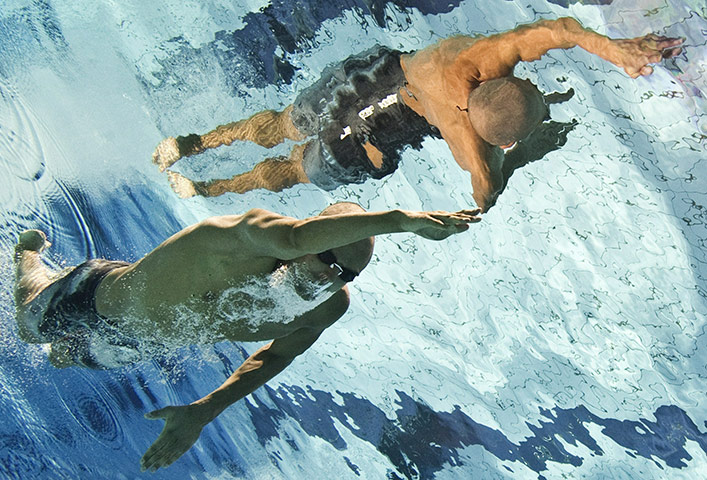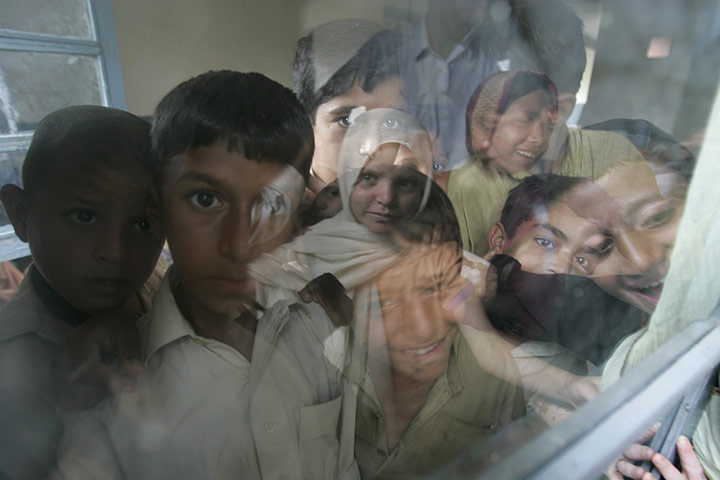The most direct means for inducing reflection about the photographic medium is to capture a literal reflection, making the photograph an image of an image. One then can ponder, for example, how a photograph is itself a trick of light sure to include some degree of distortion.

This remarkable double image reveals how the camera can see what usually will elude the unaided eye. You are looking at a swimmer in the European swimming championships, and also at his image as it is reflected off of the underside of the surface of the water. The odd, upside down inversion is disorienting: Is that two swimmers or one? Where is the surface of the pool, and which way is up or down? (I’ve spent some time studying the image just to be somewhat confident I have it right. Note that the air bubbles provide a referential anchor, and since the swimmer in the foreground is underwater the camera must be below him pointing up toward the surface.) It seems that photographic images need not be clearly legible, and precisely because they can record the visible world somewhat independently of encultured habits of perception. Fish, for example, probably would have no trouble seeing this photo for what it is.
But I suspect that only the human being can experience the uncanny. The swimmer in the background is a strange double of the first. Due to the refraction of light through water, some parts of him are a more exact reproduction than others; note, for example, how his right arm seems crippled as it is refracted by the water. The comparison between the two bodies is unsettling: instead of two toned athletes, one of them seems to be bent by disease or disability. He could be the athlete in another life, or working out when he is infirm with age. One might imagine that we each carry such images with us all the time, saved from reflection on our luck and mortality only by the absence of the right kind of mirror.
Reflections of and on reflection are not limited to existential musings. They also can be a study of collective life.

These children are reflected in a window at a camp in Pakistan for people displaced by the flooding. As above, the reflection is on a surface that usually is transparent, and again the effect can be disorienting. Are they all on the same side of the window, or only some of them? Are they enthralled and amused by their own images or by something else that we can’t see? And again the answers would not be enough to dispel the strange sense that some of those visible may not actually be of the present but rather a haunting from another dimension or another time. However one speculates, the photographer has succeeded in making one pause long enough to no longer see only the stock images of Third World Children and Disaster Refugees in a Camp.
And once again the multiple images prompt reflection on more than the nature of the camera. Instead of a few isolated children, one gets the sense of a multitude. Instead of an appeal for charity in respect to a specific event, there is the suggestion that something vital and beautiful is multiplying regardless of natural disasters and political malfeasance. There even is a theological concept that might apply: the Christian idea of a “cloud of witnesses,” past and present, whose labor, sacrifice, and presence will sustain the community of believers. These children, wherever they are, can be thought of as such a presence on behalf of a better world.
That world is not yet available to be photographed. These photos are also a study in contrasts. Water plays a role in both of them, but consider the difference between the controlled environment of the European pool and the uncontrolled rivers disrupting millions of lives in Pakistan. Together they represent a bi-polar world. The swim meet and the camp, high energy and enforced waiting, personal achievement and talent wasted, wealth and deprivation. An image and its reflection, you might say.
Photographs by Francois Xavier Marit/AFP-Getty Images and Aaron Favila/Associated Press.
[…] Reflections in a Bipolar World | NO CAPTION NEEDED And once again the multiple images prompt reflection on more than the nature of the camera. Instead of a few isolated children, one gets the sense of a multitude. Instead of an appeal for charity in respect to a specific event, […]
[…] This post was mentioned on Twitter by Philip Lang and Philip Lang, Nocaptionneeded. Nocaptionneeded said: Reflections in a Bipolar World (http://bit.ly/aubTHv) […]